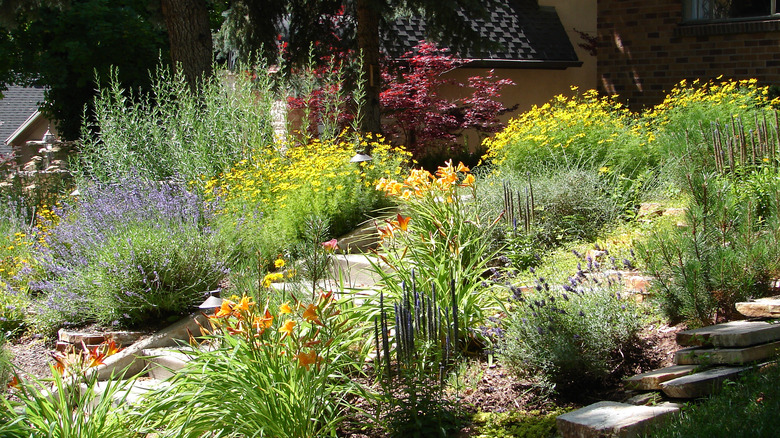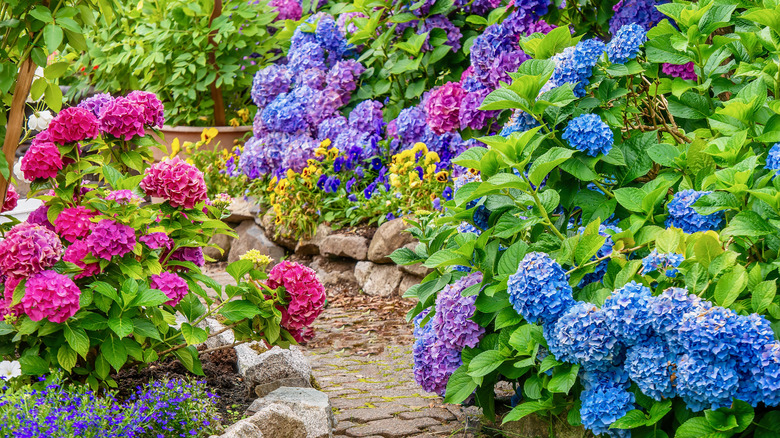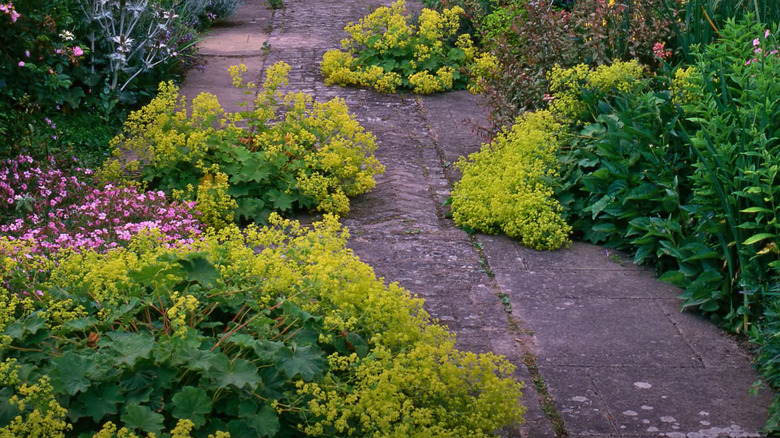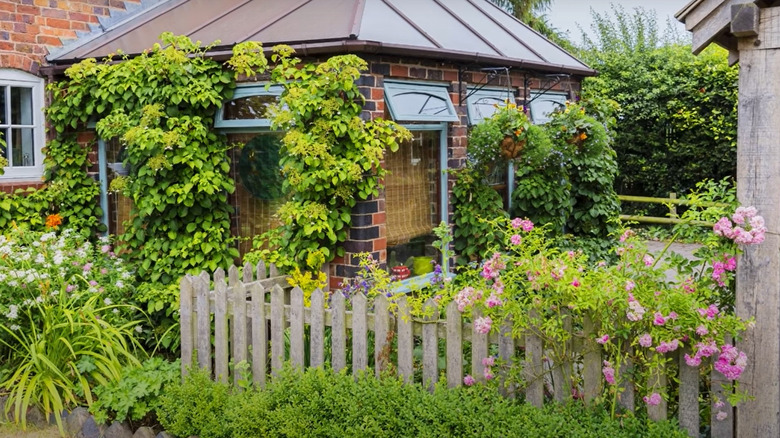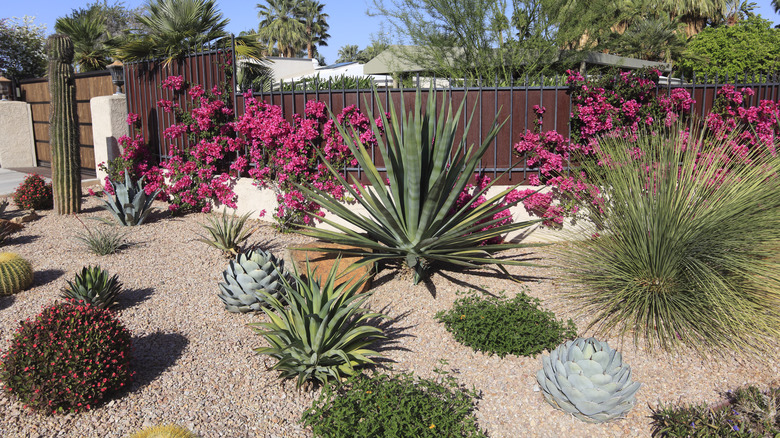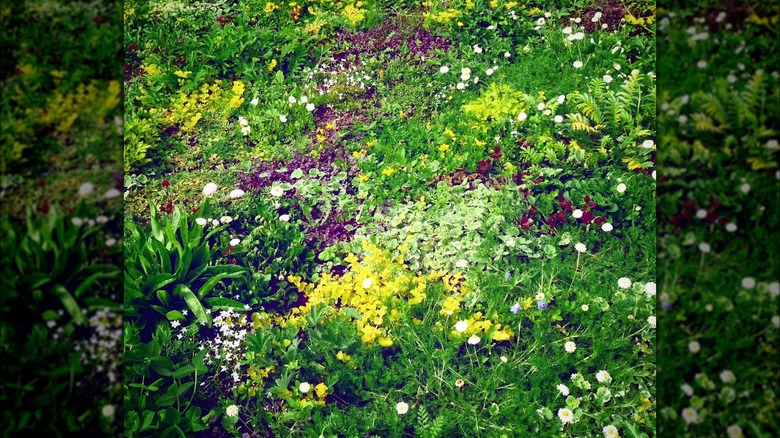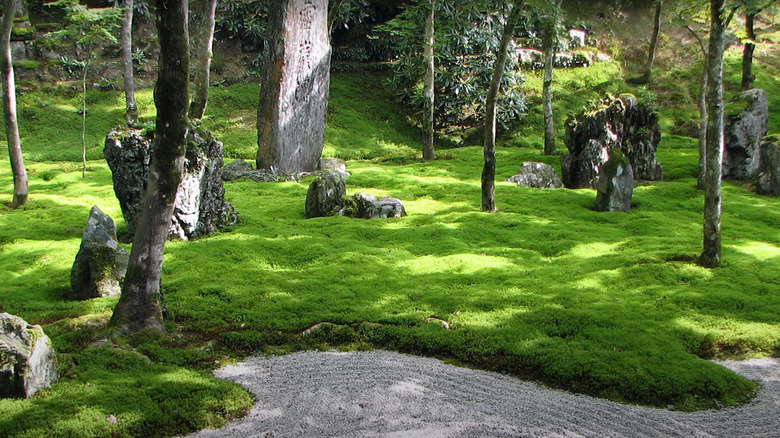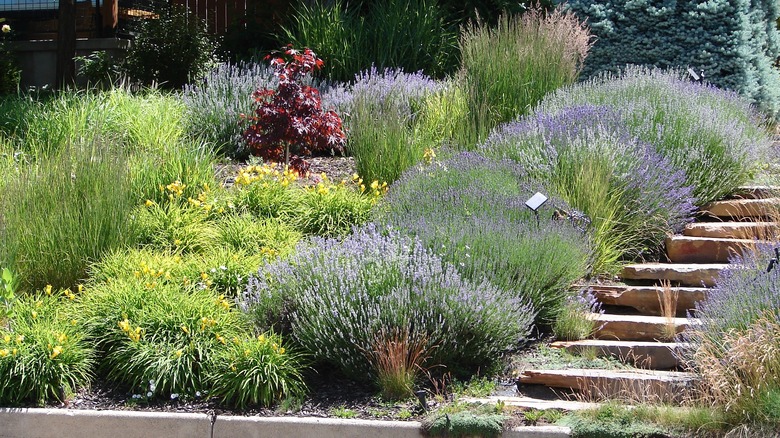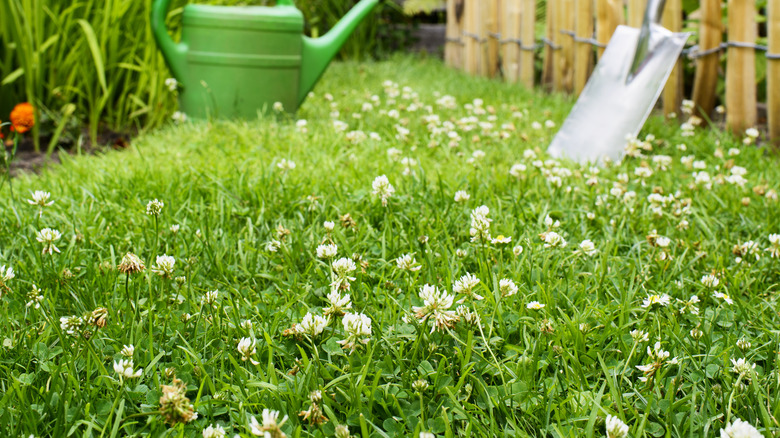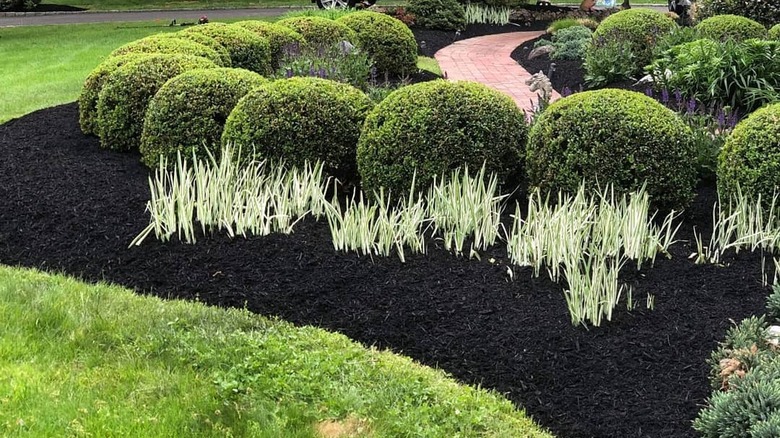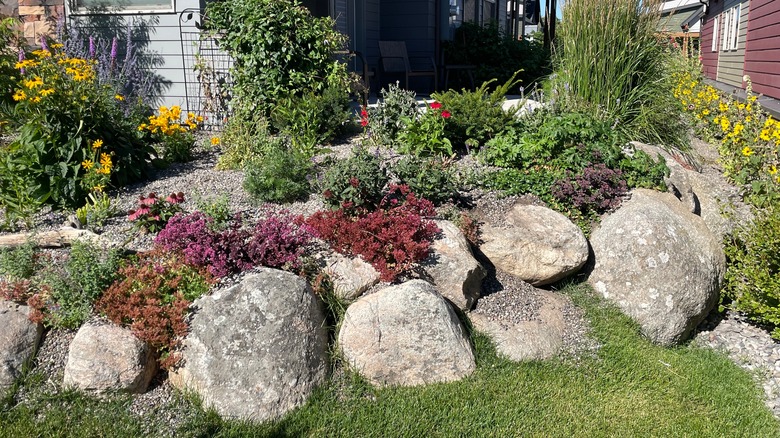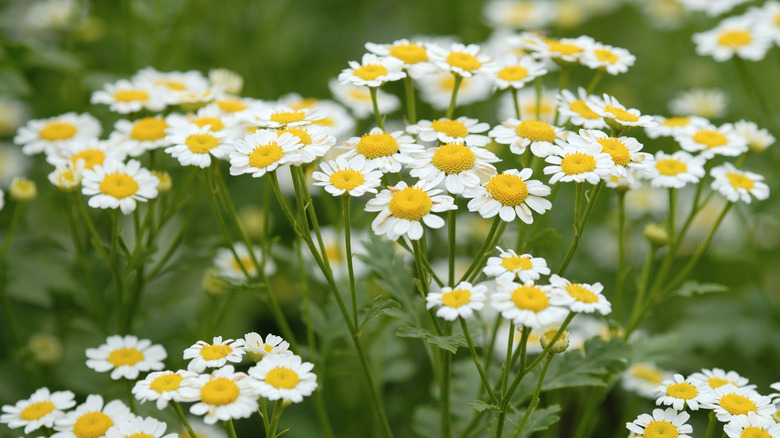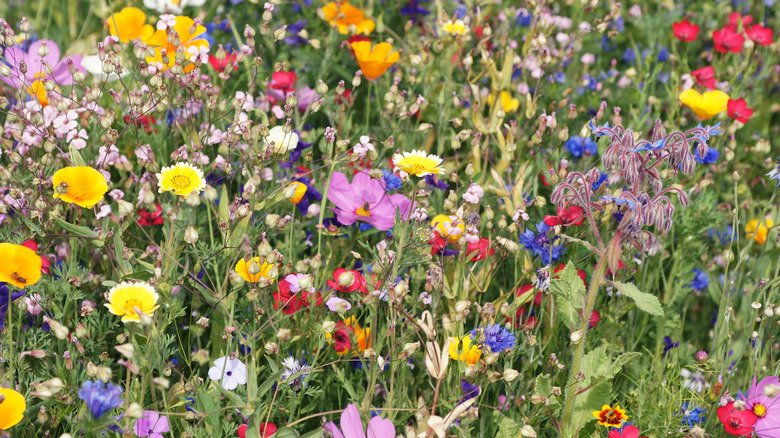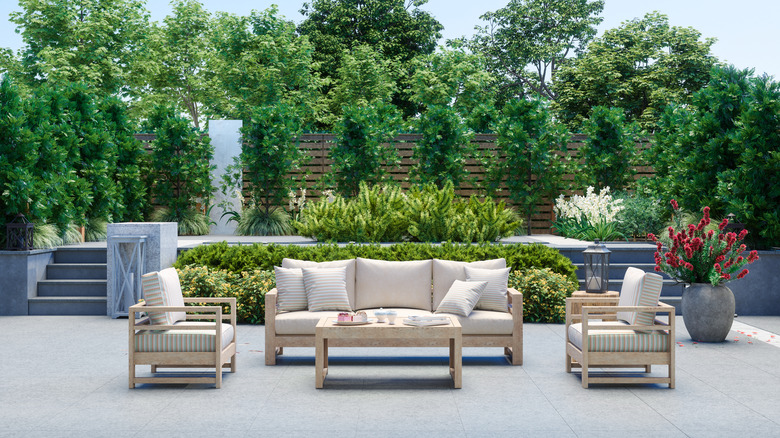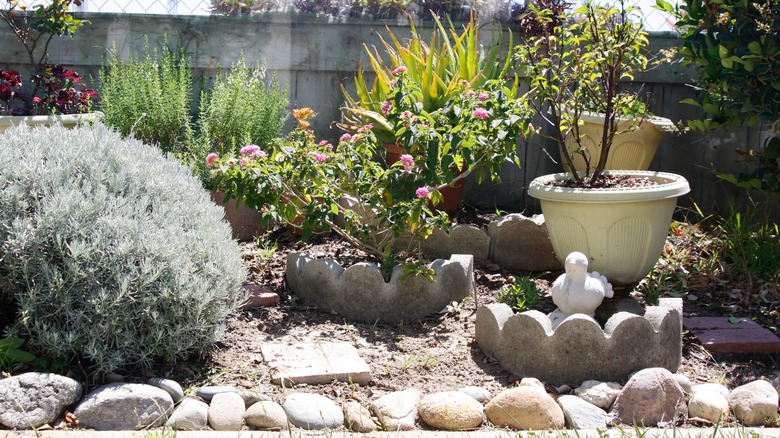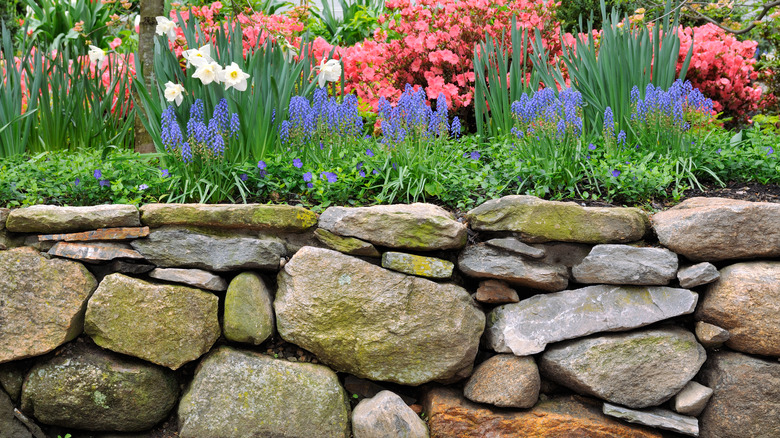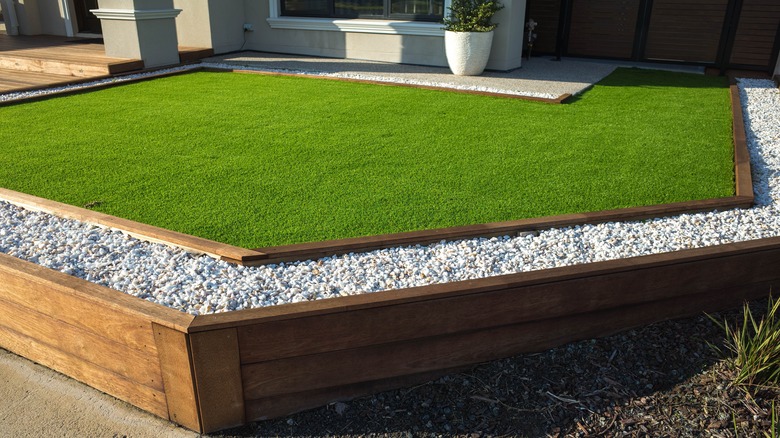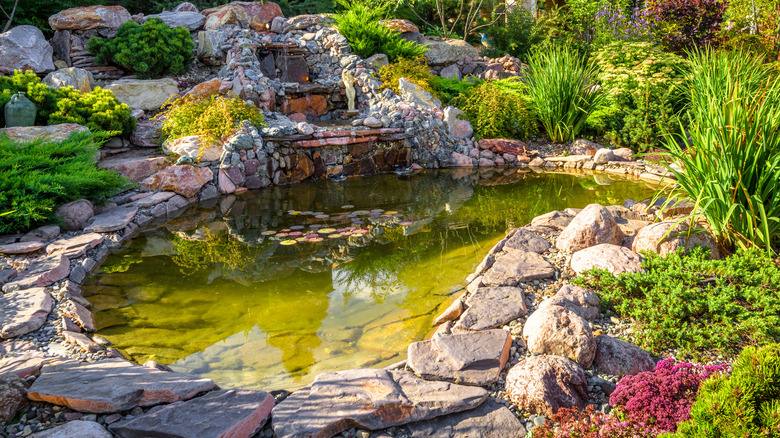Low-Maintenance Ways To Create An Eye-Catching Front Lawn Without Grass
Beauty standards change constantly, so it's no wonder our green spaces change, too. While manicured, lush lawns have enjoyed their glory, serving as darlings and sources of pride for older generations, they're now being dethroned by eco-sensitive gardeners wishing to go grass-free. And the reasons are all too clear. Lawns demand attention with frequent watering, mowing, and fertilizing. Come the weekend, it's back-to-back chores, and that cycle repeats for months until the grass finally goes dormant. To add insult to injury, even wildlife and pollinators generally avoid well-kept lawns. Besides, with water stress and climate change ruling the roost, accompanied by the active push from some states to scrap the grassy yards, it's in everyone's best interest to look for greener pastures ... sans grass, of course.
If you're looking to create a new lawn without using grass, there is an array of options at your disposal: grassy perennials, tapestry lawns, cottage gardens, evergreen groundcovers, xeriscapes, wildflower meadows, and more. Each option is easy to maintain since none of these alternatives are as power-, water-, and attention-hungry as turfs. The best part, though? You can incorporate specific elements to create a low-maintenance front lawn. For instance, succulents limit watering, native plants exhibit better adaptivity and wildlife attraction, and spreading mulch reduces weeds. So focus on your pain points, site conditions, and aesthetics, and zero in on the method that best fits your vision while giving nature free rein.
Plant beds of ornamental grass plants
The grass may not always be greener on the other side, but it can be if you plant a bed of ornamental plants like sedges. Sitting atop Cyperaceae's family tree, unlike Poaceae (grass), sedges have blades that appear and feel like turf without being one — thus christened "grass alternatives". Tolerant of shade and wet conditions, they're water-wise evergreen perennials that require little mowing. Being low maintenance isn't their best part, though. Mass-planted sedges serve as a refuge for beneficial insects and pollinators, promoting biodiversity. Besides, unlike traditional grasses, many of their varieties produce no pollen, becoming a God-send for those who suffer from allergies.
"True sedges" come in the Carex genus. With over 2,000 varieties, including Pennsylvania sedge, rosy sedge, and creeping sedge, the Carex genus is widely liked (and preferred) for its colors and textures. Plant them in drifts and let them spill, or use them to take the edge off your walkways — ice dance Japanese sedge is especially prized for its slender, white-accented, ornate green foliage. Plant no fewer than seven of each plant type if you desire diversity, and broadcast the seeds freely for a soft, natural look. Contrast heights for visual depth. But if you're looking for taller options or want to establish some leafy privacy, complement them with native ornamental grasses. They're usually unfussy and pirouette with the breeze, sure to attract you and your guests. Go blue and spiky with blue oat grass, or plant orange-turning little bluestem for fall vibes. Shenandoah and feather reed grasses offer all-season interest.
Plant ground cover
Save yourself the misery of determining whether the turf is dead or dormant by carpeting your front lawn with evergreen ground covers. Growing as a dense mat, these take up to three years to establish themselves, necessitating supplemental watering and fertilization during droughts. But once they're established, ground covers are easy to maintain, pretty much negating the need to weed. Since they're short, you can completely forgo mowing.
While it's a good idea to opt for ground covers instead of grass for your lawn, not all ground covers give you ample recreational space. So if you've got kids and pets who love running amok, plant varieties that can be stepped on. Creeping jenny, thyme, moss rose, Scotch moss, and Corsican mint are excellent options.
Given the erosion control, ground covers are perfect for slopes and are recommended if the decline exceeds 12%. But use netting or mulch until they mature. As they easily absorb dust, glare, and heat, they work better for adding curb appeal compared to pavers. In smaller yards, it's smart to mass-plant a single variety. The colorful, fast-growing lilyturf, for example, survives in dappled light, while sweet flag grass feels at home in marshy areas. For a fragrant spin, look for sweet woodruff and Roman chamomile. If you prize rich textures, interplant different varieties and layer them by height or blooming season. For instance, in colder, partially shaded areas, complement woodruff's emerald green whorls with lady's mantle scalloped foliage for successive blooming. Likewise, sea holly and lamb's ears pair well in sunny yards. Steer clear of invasive plants like English ivy and vinca — Invasive.org has an area-specific list.
Design a cottage garden
Rebuffing everything that Victorian gardens stood for — embellishments, grandeur, and pretentious, formal design — cottage gardens are an artless, supple hodgepodge of quaint flowers, decorative edibles, rambling vines, and curving pathways. Their informality gives your creativity and imagination wings, allowing you to add a personal touch and character to your landscape. There are no rules for you to follow. Simply wedge in the plants that pique your interest and watch the resilient ones survive and bloom. That lax design makes them low-maintenance. Blythe Yost, a landscape architect, told Architectural Digest, "I would probably consider a cottage garden as the most low-maintenance, as it's the most forgiving." Of course, choose types hardy to your zone and site conditions to save on labor and time uprooting dejected plants.
To design and plant the perfect cottage garden, think of all the elements you want in your front lawn. If the plan is to evoke childhood memories of frolicking about your grandma's garden, add latticed bamboo, willow trees, or white pickets to fence the blooms. Move on to densely packing long-lasting or self-seeding annuals, such as cockscomb and love-in-a-mist, although calendulas and violas work just as beautifully. Some perennial plants that are perfect for your garden include catmint, coneflowers, and peonies. Use ground covers like bellflowers and creeping jenny as edges. Mix in sweet peas as climbers. Go hard on native plants and birdbaths for ecological brownie points. A gravel or brick path could tie the whole garden together.
Develop a succulent oasis
Go green with vibrantly hued, sculptural succulents that transform your front lawn into a head-turner — and yes, there's more to them than just cacti. Echeveria, crassula, agave, dichondra, and aloe vera are a few popular succulents. As water-storing plants, succulents are the real deal in arid, desert climates, especially the southwestern parts (zones 9 to 11) that experience a lot of sun and sandy soils. Although some varieties, such as ice plants and hens and chicks, can survive cold climates, they're best kept potted. Succulents' high drought tolerance lowers your watering responsibilities, making them a keeper in water-wise landscapes. Growing drought-tolerant plants is the gardening trend going huge in 2024, after all.
Your succulent lawn can assume varied forms. Try weaving a tapestry by tucking in several plants of varying heights but sharing the color palette. For instance, yuccas, with their sword-shaped rosette, couple well with the basal green and waxy leaves of agave. To add texture, incorporate blue chalksticks and strings-of-pearls. If the soils drain poorly, build berms or raised beds supporting barrel cactus and prickly pears (paddle cactus). For rainy areas, create a creek bed of river stones and encircle it with jade plants and aeoniums. Counterintuitively, you can craft a coral reef or sea garden look with succulents. With its powdery blue foliage blushing pink at maturity, Echeveria glauca is the perfect candidate for such a design. Pair it with red-margined, rounded white leaves of Cotyledon "ivory shell."
Grow a tapestry lawn
Unroll a welcome mat for pollinators and wildlife by turning your yard into a tapestry lawn or prairie garden. Conceived of and introduced by Dr. Lionel Smith in 2019, tapestry lawns are a breath of fresh air from the staid, groomed look associated with front lawns. As the name suggests, you "knit together" diverse flowering native perennials with similar care requirements. But they differ in statures, textures, and blooming cycles, appearing as an ever-changing mosaic through the seasons. They're considered low-maintenance because they allow nature to take over instead of following a strict set of rules. This means you'll have to mow your tapestry lawn about three or four times at most a year. While regular watering and fertilizing are essential for the seeds to germinate, the lawns are unfussy thereafter.
To design a tapestry lawn, cherry-pick native plants, especially the drought-tolerant varieties, and patch them together based on light and resource requirements. Arrange them so the groups don't compete against each other. Moss phlox, calico aster, slender mountain mint, and ground plum best suit sunny, well-draining soils. But switch to self-seeding annuals like baby blue eyes and five-spot buffalo eyes for poor substrates. Complement with grass-like perennials like wild ginger, goldstar, and foamflowers. In shaded regions, grow Irish moss, but if the soil is dry and acidic, raise mountain-lover instead. However, remember that tapestry lawns can't withstand high foot traffic, so install a stepping stone walkway to make them more functional.
Switch to moss
Going back over 450 million years, mosses are true-blue, non-flowering fossils that have survived the test of time, making them a durable planting choice against the backdrop of climate change. With over 15,000 species, moss has anchored itself in many habitats, so finding an alternative for your front lawn isn't a tall task. With fern moss, Scotch moss, Irish moss, and pincushion moss, some varieties easily flourish in partially and fully shaded yards. The best part, though? They soak up rainwater, so you can upgrade to rain or woodland gardens later. While a little maintenance may be necessary for newly sodded moss, they fill in quickly, dispensing the need for fertilizer. Compacted, clay soils are no bar, either. As for mowing? That's never happening. In fact, if you plant mosses as understories, you have to cast a net over the moss to collect any leaf droppings. Their ability to self-fertilize is an added advantage.
Despite all the perks, sodding a mossy carpet is difficult if your lawn doesn't have a compatible history. But if you think your landscape has the right conditions, source clumps from a local vendor and transplant them. Ensure they carry soil-covered rhizoids or they won't spread out. Avoid treating them with food additives to stimulate growth; instead, hold them in place with moss pins or toothpicks. If you're considering converting to a moss lawn, you'll also want to accent it with boulders or gravel sidewalks. Or opt for companion planting with hosta, lady ferns, and liverworts.
Utilize xeriscaping
First embraced in drought-prone, western regions, such as Colorado, the xeriscaping trend has helped many gardeners to save water. This minimum-water landscaping technique is alleged, according to National Geographic, to cut down water usage by almost 50% to 75%. One Nevada-based experiment in 2005 found that adopting xeriscaping reduced annual household consumption by a massive 96,000 gallons, or 30%. Xeriscaping involves planting climate-adaptive, native vegetation interspersed with mulch, gravel, and soil. As a result, it's very low-maintenance, requiring a yearly round of mulching at most. While cacti are certainly the stars of the show — as they are in Western movies — they aren't the only choices. Xerophytes like ocotillo are fairly popular, as are daffodils. One could also mix in resilient trees like myrtles.
The key to designing an eye-catching, no-grass front lawn with xeriscaping is to aggregate drought-resistant plant bushes based on their water requirements. So the relatively heavy users should be placed closer to a water source, such as drips or soakers, and the rest can be layered farther away. Consider adorning the lawn with perennials like lavender and juniper. Blend in edibles like oregano and thyme. You can even integrate food crops, such as Jerusalem artichokes and black walnuts, into the design. Insert hardscaping elements that encourage water flow, unless you are willing to lace the area with rain barrels. For added visual depth, feature tan or beige rocks. Take care to skip darker shades, as they heat up quickly.
Cover with clover
Clover is the new go-to lawn cover. Despite their checkered history, clover lawns have experienced a surprising resurgence as gardeners are ready to give up their lawnmowers. They usually require a light trim thrice a year — even less if grown out fully to attain the look of an English garden. These under-a-foot-tall, herbaceous perennials have trifoliate leaves, mottled with purplish-red spots, maintaining their façade right through the hottest summers when most turfgrasses falter. They reward their growers with edible white flowers that can be used in teas. Plus, they charm clouded sulfur butterflies into resting on them mid-flight, doubling up as a pollinator haven! So should you plant a clover lawn?
Clover plants aren't snarky about the soils or the weather, prospering in zones 3 to 10. Upkeep is easy if they're given four to six hours of sunlight. Even pests and diseases pose little concern. They aren't water-hungry, are affordable, and enrich the soil with nitrogen. While they're not terribly attractive to pesky invaders like rabbits and squirrels, they do attract honeybees. So they aren't the safest choice if you like strolling on the lawn to unwind or if you're allergic. Moreover, as they die down completely in winter, it's ideal to club micro-clovers with ornamental grasses like Kentucky bluegrass or tall fescue to avoid getting a muddy lawn. Otherwise, planting Dutch white clover in between cobbled paths is a possibility.
Center your lawn around mulch
Ditch the grass and embrace mulch as your front lawn's ultimate showstopper. While usually boxed in as a soil amendment to be used around flower beds and trees, there are multiple ways to spread a 2- to 4-inch mulch layer without sacrificing its benefits, since it's available in varying sizes, textures, and colors. For instance, bark mulches are quite popular and come in scores of sizes, from finely chopped to large chunks, with some dyed in vibrant red, brown, and black hues. While some have raised concerns over color toxicity and chemical treatment, dyed mulches can be used if you're sure the wood was sourced safely or if the safety sheets point to no immediate concerns. But if you can't be bothered to do your homework, pine bark mulches are another option. Additionally, there are aromatic, light brown cocoa bean shells that appease chocolate lovers and roses alike. Other worthy alternatives include sawdust, pine needles, wood chips, and straw.
The trick to having the front yard revolve around mulch is to plant a few drought-tolerant species and cover the rest of the area with contrasting organic mulches. This will cut down your lawn's water needs drastically without making it necessary to compromise on aesthetics. You could also create mini-zones of flowering perennials, edibles, and ornamentals and define their boundaries with distinct mulches. If necessary, add a few boulders and free-standing planters to your mulch bed for added interest. Alternatively, use mulch to create discrete paths within the lawn.
Go big with boulders and gravel
Rocks are as low-maintenance as anything can get. They're never parched or hungry for nutrients. Though they may get uncomfortably hot, they're perfect for arid climates, too. Sometimes, weeds can become a problem, but they're nothing a little hand-weeding can't handle. Although they won't build up the soil, rocks and boulders surely enliven the front yard with their variety. To illustrate, you can have big boulders grace the entrance and bury them a third in to lend the lawn a natural yet dramatic aesthetic. However, don't exceed 2 feet in diameter for smaller fronts. You can also place plants adjacent to the stones to play off different textures and heights.
Using rocks and boulders offers a multitude of design options for your lawn. Use a few big rocks as anchor points in your yard, leaving adequate space for plants. In shaded areas, interplant ferns, astilbe, or coral bells and complement them with bulbs like crocus, begonias, and snowdrops. Use moss as ground cover or pair with contrasting smaller pebbles and gravel to make a landscape reminiscent of alpine areas. Or draw inspiration from Japanese rock gardens and lay down white gravel. Stick to lighter shades to keep the lawn bright. Accent rough rocks with creeping vines for a soft look. If you prefer Mediterranean expressions, choose plants with silverish or blue foliage, such as Artemisia or lamb's-ear, and style them with gravel. (Just be careful when you mow or weed-whack.) Interestingly, gravel gardens are trending at the moment, with some practitioners removing the top 4 to 5 inches of topsoil to dissuade weed and runoff and replacing it with gravel and native plants.
Carpet with chamomile
Chamomile, the stuff that goes in your herbal tea, is another low-maintenance grass alternative you may want to consider. Gracing the Buckingham Palace even today, chamomiles are a lovely groundcover, requiring little mowing to keep them in shape. They love baking in the sun, maintaining their verdure no matter how hot it gets. They give poor soils a free pass as long as they drain well, radically lowering their fertilizer requirements. Since pests are a non-issue, except aphids, they should be your go-to if reducing treatments is a priority. Like most plants, they require irrigation support until they root fully but develop drought resistance afterward.
Primarily, two main varieties of the plant are used on lawns. If you'd rather keep a lush green look, Chamaemelum nobile "Treneague" is the way to go, as it doesn't flower at all. Plus, it doesn't require pruning, stays under 4 inches, and can be easily transplanted. But to enjoy the dainty, yellow-centered white flowers, opt for Chamaemelum nobile dwarf. While they don't particularly look forward to being trampled upon, they emit an apple-like fragrance when bruised. That being said, the perennials remain delicate throughout their first year of establishment and should only experience occasional foot traffic. If that's hard to achieve, place stepping stones to ease the pressure. Remember, you might have to pinch the chamomile plants now and then to prevent them from growing straggly.
Plant a wildflower meadow
If you're a grassland lover, planting a wildflower meadow is a low-maintenance way to get the desired look. Emulating mother nature, they include an ephemeral mix of region-adapted wildflowers, forbs, bulbs, and native grasses. As you can imagine, birds, butterflies, and beneficial insects flock to these areas in spades. These spirited ecosystems work best in full sunlight (over six hours) and require at least 400 square feet to reap real benefits. Naturally, this can get expensive, especially if you're planting commercially available wildflower mixes. However, you save on irrigation, fertilization, and mowing in the long run. Plus, they're an aesthetic way to control soil erosion.
There are two paths you can take to create a wildflower meadow, with annuals being the quickest. Encompassing the likes of cornflowers, corn marigolds, and poppies, they perform well in fertile soils. The downside is that they must be resown in the new season. The flip side focuses on starting a perennial meadow, especially in deficient soils, containing pollinator-friendly native and non-native forbs. Though the list varies per eco-region, oxeye daisies, ragged robins, clovers, and knapweed may make the list. But perennials can take almost three years to mature, necessitating routine weeding to prevent them from growing unwieldy. So they fare better in open areas and low-recreational spaces or should be adorned with garden paths for better functionality. Starting directly with plugs helps, too. Prettify your lawn by mixing in snowdrops, tulips, and aconites. Sod buffalograss, sideoats grama, and similar native grasses to fill in gaps.
Equip the area with hardscaping
Admittedly, while there are quite a few gorgeous, low-maintenance forbs, they can't beat hardscaping when attention is truly sparse. Embodying non-living — synthetic or natural — elements like patios, decks, pergolas, gazebos, fire pits, walkways, and more, there's plenty you can do with your front lawn if you want to upend it. Generally, most people default to gravel sidewalks or concrete pavers. This takes the pressure off the groundcovers while breaking the monotony of the landscape. Others may swap in stone or brick paths that allow for rainwater permeation, all the while retaining functionality. You can further add textural depth by contrasting concrete with pebbles and perhaps design them as snaking paths or as intersecting L-shapes for a modeled look. However, you must line them with landscape fabric to thwart weed encroachment. For a beachy look, lay down crushed shells and edge them off with stones to avoid spillage.
Another classic approach is to build a deck or a porch as the mainstay of your front yard. Embellish the area with potted plants and seating and you're all set to enjoy your morning cup of joe. Erect a vined trellis in front or grow flowering dwarf trees in case privacy is key. Don't forget to install recessed lighting and metal sculptures if you plan to host guests. Conversely, you can complement your xeric plants with an underlit staggered wooden staircase placed smack dab in their center, exuding a quality best matching "The Dune."
Maintain an herb garden
Herbs are aromatic, medicinal, and aesthetic. In cooking, herbs are great for marinades and roasting. Above all, herbs are easy to upkeep! There are ample reasons to grow an herb garden when you're going grass-less. And when you do, you earn the appreciation of butterflies and bees. Thyme and rosemary are perfect for bees and butterflies alike, while lavender will give you a heavenly smell in the garden. Such herbs also imbue your front with a Mediterranean aesthetic, which you can develop further by mingling in scores of haphazardly placed landscaping rocks.
Look for stones that naturally merge with the design, such as pebbles and gravel. This conserves water, making the herb garden low-maintenance and ideal for perennial companions like oregano and thyme, known to survive dry conditions and poor watering. Succulents are a laudable addition for cohesiveness. Afterward, accessorize with outdoor chairs or build stone steps so you and your guests can delight in their scent.
If you choose to plant multiple herbs, there's an art to interplanting them. Many herb-growers group them by themes. For instance, you can make an Italian paradise by growing basil, rosemary, and parsley in one mini-zone. Similarly, a large pot or planter could house various mint varieties although they die back in winter. Interestingly, some contour these zones into triangular, circular, or square shapes, filling the rest with bark and wood chips. Punctuating the lawn with herb spirals and knot gardens is a thing, too.
Stack stones as walls
Another way to make your front lawn stand out is to stand a set of stacked stones at the entrance. The trick is to heap them up without affixing them with mortar. The more asymmetrical and bumpier the stones, the more natural their appearance. Such walls particularly harmonize well with homes designed in rustic styles. In case your yard happens to be on a slope, the stone wall can follow the incline, narrowing (or thickening) accordingly to echo an organic setting.
Top it off by planting evergreen shrubs or climbers that fit right into the tiniest nooks and crevices while generating an aesthetic contrast. For instance, Californian lilacs go well on sunny walls, with their blue and rarely pink blooms. Likewise, daisy bush adds laurels to coastal garden walls through its yellow-centered white flowers dotting against silver foliage that withstands the harshest winds. You can also stack up stones to create retaining walls that will hold back soil and water runoff. If staggered, they can even double up as stairs connecting two levels. Pair them with red mulch to generate a flaming contrast. This will further accentuate the lush perennials planted on your front lawn.
Design with artificial turf
If a regimented, manicured lawn is your top choice, say hello to artificial turf. Made of synthetic fibers, mostly nylon or polypropylene, artificial grasses don't thirst for water, making them popular in and around water-hungry, always-sunny Southern states. Since the blades don't grow, they put lawnmowers out of business ... permanently. As a bonus, they spare you the hassle of aeration, fertilization, and chemical treatments, leading to massive savings. Best of all, they're safe to use around kids and pets — minus the sensory touch that natural lawns offer — and can brave their mischievous antics, lasting for decades at a stretch. To boot, they are made in a plethora of styles, ranging from W- and V-shaped blades to oval or diamond profiles. You can attire your entire yard with artificial turf so that you can play your soccer game uninterrupted. Or interlace it with pathways and patios. Cordoning off the area with landscape rocks is another way to style it, as is packing in a fountain right in its center.
But before installing artificial grass, be wary of its pitfalls. In intense heat, artificial turf becomes crazy hot, pretty much making it unusable. Also, it supports no biodiversity, so kiss goodbye to dreams of chasing butterflies or housing squirrels and birds in your yard. Moreover, their durability has a price (and carbon footprint) to match, rising further when the pros install a permeable base underneath for water filtration. Finally, they need vacuuming, raking, and blowing to keep clean.
Costar a water feature
Water ponds don't exactly scream "low-maintenance" and need to be constantly cleaned. But surprisingly, natural ponds or ecosystem ponds are finally seeing the limelight, thanks to their minimal requirements for human intervention. What's at play here is that, first, the pond is located in an area that isn't surrounded by tall trees. This will limit its collection of shade and shed leaves. Later, you place aquatic and oxygenating flora, such as water lilies, water hyacinths, Egyptian papyrus, and mosaic plants, into the pond. As they use up the nutrients that otherwise would fatten up algae, they nip the cleaning problem right in the bud. However, support the floating plants by encircling the pond with water-loving margin vegetation like giant rhubarb, ferns, marsh marigolds, and iris. Be ready to have the pond raided by dragonflies, tadpoles, and frogs in sunny lawns.
Although you can supplement the aesthetic with koi or goldfish, limit them to no more than 10 for every 100 gallons, lest they pose problems. Instead, embroider the area with sand, boulders, stones, and wood decks. The main drawback of natural ponds is that they cost quite a pretty penny and may not work with your budget. Under such circumstances, choose smaller features like a water bowl or fountain that you can DIY by recycling weathered stone bowls or steel dishes and float aquatic plants. Or put up birdbaths to entice songbirds.
